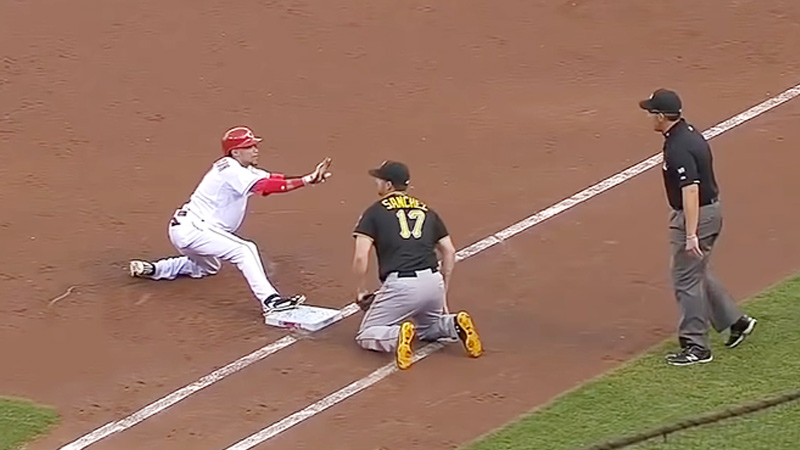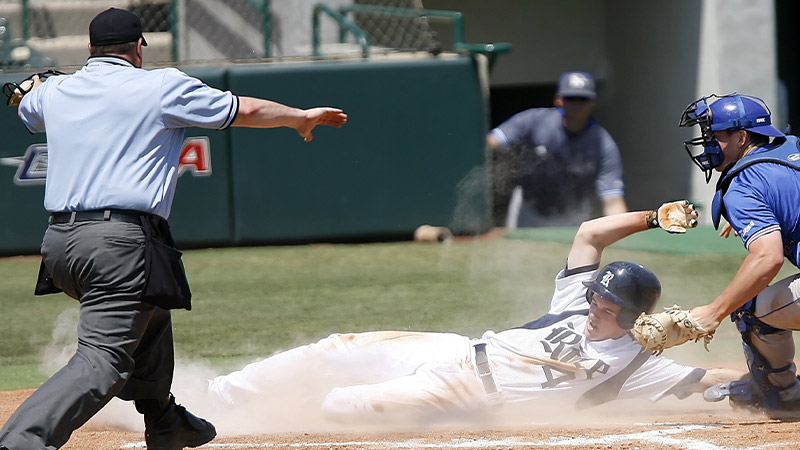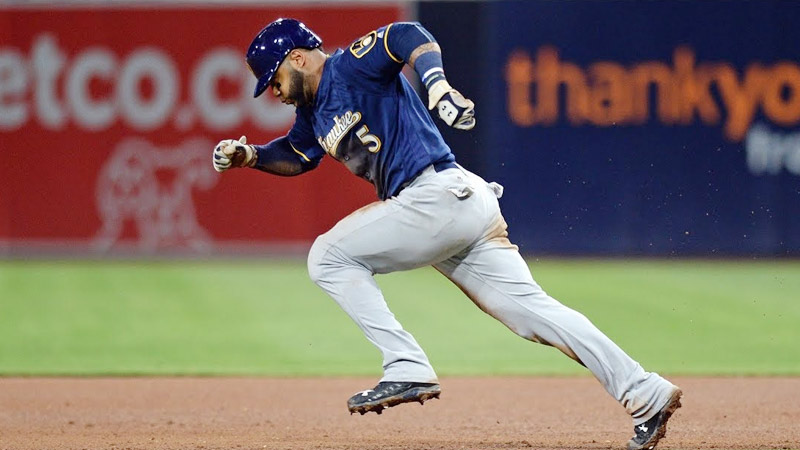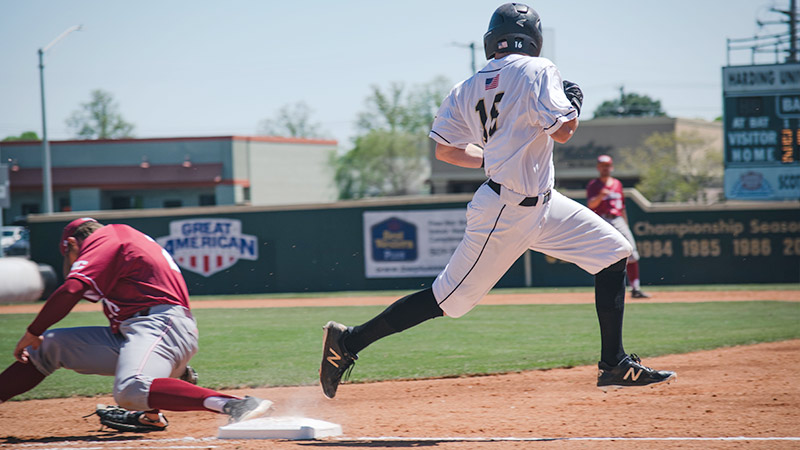As one of the most debated and consequential aspects of the game, understanding the rules and implications of runner interference is essential for players, coaches, and fans alike.
Eventually, we often fail to understand all the rules on Runner interference in baseball. But it is very essential to be aware of these facts because it is almost not possible to enjoy the entire match without understanding the rules.
Well, if you are one of those who still don’t understand the rules, you are in the right place. In this guide, we will explore the definition, instances, consequences, and key considerations of runner interference in baseball.
Runner Interference
We can describe the runner interference in the context of a few essential factors. They are described right below.
Runner Interference in Relation to Fielder’s Play
Runner interference occurs when a baserunner interferes with a fielder’s ability to field a batted ball or make a play. This interference can take various forms, including physical contact, impeding the fielder’s path, or creating distractions that hinder the fielder’s concentration.
It is important to note that runner interference only applies to situations involving a batted ball, not during other plays on the field.
Rule Regarding Vacating Space for Fielder
According to the rules, a baserunner must vacate the space needed by a fielder attempting to field a batted ball, unless the runner is in contact with a base.
This means that if a fielder has a reasonable opportunity to field the ball, the baserunner should not obstruct or hinder the fielder’s path. The runner must either yield the space or attempt to avoid interfering with the play.
Intentional Interference and Its Consequences
Intentional interference occurs when a baserunner deliberately obstructs a fielder’s ability to make a play. This can include actions such as purposefully colliding with a fielder or intentionally impeding their movement.
Intentional interference is strictly prohibited and carries severe consequences. The umpire may call the runner out and even eject them from the game, depending on the severity of the interference.
In cases of unintentional interference, where the runner does not intentionally obstruct the fielder but still interferes with the play, the consequences may vary.
The umpire will use their judgment to determine the appropriate outcome, which can range from declaring the batter or baserunner out to allowing the play to continue without penalty, depending on the circumstances.
Instances of Runner Interference
Runner interference without physical contact can arise from a variety of actions. Some common examples include:
Verbal Distractions
If a baserunner intentionally shouts or yells in an attempt to distract or confuse a fielder, it can be considered interference. This tactic aims to disrupt the fielder’s concentration and prevent them from making a play.
Misleading Actions
If a baserunner intentionally makes a sudden move towards another base, causing the fielder to react and potentially miss a play, it can be deemed interference. The runner’s deceptive actions hinder the fielder’s ability to effectively execute their defensive responsibilities.
Fake Slides
When a baserunner executes a fake slide, simulating a slide towards a base without actually making contact with the ground, it can be interpreted as interference. This deceptive maneuver can confuse the fielder, affecting their timing and decision-making.
Impact on Fielder’s Ability to Make a Play

Non-contact runner interference can significantly impact a fielder’s ability to make a play on a batted ball. By employing distracting tactics or deceptive actions, the baserunner creates a disadvantage for the fielder, disrupting their focus and altering their defensive positioning.
The consequences of non-contact interference vary based on the specific situation and the umpire’s judgment. If the interference is determined to be unintentional or negligible, the play may continue without penalty.
However, intentional non-contact interference can result in the baserunner being called out and potentially ejected from the game, depending on the severity of the interference.
It is essential for players, coaches, and umpires to be aware of non-contact runner interference and its potential impact on the game. Clear communication and understanding of the rules can help prevent such interference and ensure fair competition on the field.
Contact Interference
Contact interference typically arises when there is physical interaction between the baserunner and a fielder attempting to make a play. Some common scenarios include:
Collisions at Bases
When a baserunner and a fielder collide while the fielder is attempting to receive a throw or tag the runner, it can be considered contact interference. These collisions can occur at any base, and the severity of the collision will impact the umpire’s decision.
Interference During a Rundown
In a rundown situation, where a baserunner is caught between two bases and multiple fielders are involved in the play, contact interference can occur. If the baserunner initiates contact with a fielder in an attempt to impede their ability to make a play, it is considered interference.
Determining Factors for Interference in Contact Situations
When assessing contact interference, umpires consider several factors to determine if the runner interfered with the fielder’s ability to make a play.
These factors include:
Intent
Umpires assess whether the runner’s contact was intentional or accidental. If the runner deliberately initiates contact with the fielder, it is more likely to be deemed interference. Accidental contact, on the other hand, may be seen as incidental and not interfere with the play.
Obstruction
Umpires evaluate whether the runner obstructed the fielder’s path or impeded their ability to field the ball or make a tag. If the contact hinders the fielder’s actions and prevents them from executing a play, it is more likely to be considered interference.
Positioning
The positioning of both the runner and the fielder at the time of contact is crucial. Umpires assess whether the runner deviated from their base path and made unnecessary or excessive contact with the fielder.
It is important to note that determining interference in contact situations can be subjective, and the umpire’s judgment plays a significant role. The umpire will consider the specific circumstances and apply the rules accordingly to maintain fairness and uphold the integrity of the game.
Umpire’s Judgment

Umpires are the ultimate authority on the field, entrusted with the task of making critical decisions, including those related to runner interference.
They are responsible for observing and evaluating the actions of both the baserunners and fielders to determine if interference has occurred. The umpire’s primary objective is to ensure fair competition and maintain the integrity of the game.
Factors Considered by the Umpire in Making a Judgment Call
Umpires take several factors into account when making a judgment call on runner interference.
These factors include:
Positioning
Umpires assess the positioning of both the runner and the fielder at the time of the alleged interference. They consider whether the runner deviated from their base path or the fielder was obstructed in their attempt to make a play.
Timing
The timing of the interference is crucial. Umpires evaluate whether the interference occurred before, during, or after a play. A late slide or unnecessary contact after a play has already been completed may be deemed interference.
Intent
Umpires try to discern the intent of the runner. They consider whether the contact was intentional, accidental, or incidental to the normal course of the game. Deliberate actions to impede the fielder’s ability to make a play are more likely to be viewed as interference.
Potential Challenges and Controversies
Interpreting runner interference can be challenging and may lead to controversies in some cases. The subjective nature of certain situations and the need to make split-second decisions contribute to the difficulties umpires face.
Additionally, the interpretation of the rules surrounding interference can vary, which can lead to disagreements between players, coaches, and umpires.
Controversies can arise when there are differing opinions on whether the runner’s actions truly impeded the fielder’s ability to make a play. Close plays, collisions at bases, and rundown situations are particularly prone to disputes.
In such cases, replay reviews may be used to assist in the decision-making process, although not all levels of baseball have access to this technology.
Umpires strive to maintain consistency and fairness while interpreting runner interference, but the human element involved means that disagreements and controversies may still occur.
Clear communication, adherence to established guidelines, and ongoing training for umpires are essential in minimizing such challenges and ensuring the accurate application of the rules.
Consequences of Runner Interference

When runner interference is called, the immediate outcome for the runner is typically an out. The umpire will declare the runner who committed the interference as out, and any other runners affected by the interference may also be called out, depending on the circumstances.
This can significantly impact the offensive team’s ability to advance on the bases and potentially score runs. The offensive team may lose scoring opportunities, and the order of baserunners may be altered as a result.
Impact on Baserunners and Potential Base-running Implications
Runner interference can have a cascading effect on baserunners. If the interference results in multiple outs, baserunners who were forced to advance due to the batter becoming a runner may be forced to return to their original base.
The interference can disrupt the flow of the game and nullify any advancements made by the offensive team. It is essential for baserunners to be aware of the rules regarding interference to avoid costly mistakes and potential outs.
Furthermore, runner interference can lead to strategic implications in base running. Runners may need to adjust their approach to avoid interference, such as sliding earlier or altering their path to avoid contact with fielders.
Coaches and base runners must communicate effectively to ensure that everyone is on the same page and aware of the potential risks associated with interference.
Role of the Umpire in Making the Appropriate Call
Umpires play a crucial role in identifying and penalizing runner interference. When interference occurs, the umpire must make a judgment call and enforce the appropriate penalties.
This involves observing the actions of both the runner and the fielder, assessing the impact on the play, and applying the relevant rules.
The umpire’s decision may result in immediate consequences, such as declaring the runner out or calling other runners out. Umpires must communicate the ruling effectively to all parties involved, including the players, coaches, and scorekeepers, to ensure clarity and fair play.
In some cases, umpires may consult with their fellow umpires to make the correct call, especially in situations where multiple runners are involved or the interference is complex.
Cooperation and communication between umpires are crucial in reaching a consensus and upholding the integrity of the game.
Enforcing penalties for runner interference not only addresses the immediate situation but also serves as a deterrent to prevent future incidents. The umpire’s role in enforcing penalties helps maintain fair competition, discourages unsportsmanlike behavior, and ensures that the rules are applied consistently throughout the game.
By understanding the consequences of runner interference and the role of the umpire in making the appropriate call, players, coaches, and fans can better appreciate the importance of playing within the boundaries of the rules and promoting fair competition.
Key Considerations and Clarifications
There are a few specific terms of consideration and clarifications that you need to consider in this context.
Distinction Between Runner Interference and Obstruction
While runner interference and obstruction are related concepts, they have distinct differences that must be understood. Runner interference refers to the actions of the runner that impede the fielder’s ability to make a play, either through physical contact or non-contact actions.
On the other hand, obstruction involves the actions of a fielder that hinder the progress of a baserunner who is legally attempting to advance.
It is crucial to differentiate between these two concepts as they have different implications and consequences. Runner interference primarily focuses on the runner’s actions affecting the play, while obstruction centers on the fielder’s actions impeding the runner’s progress.
Relevant Rules and Regulations
To effectively navigate the realm of runner interference, it is important to be familiar with the specific rules and regulations governing this aspect of the game.
Major league baseball follows the rules set forth by the Official Baseball Rules (OBR) and the specific guidelines provided by the appropriate governing bodies.
Key rules related to runner interference can be found in Rule 5.09 (a) of the OBR, which outlines the circumstances under which a runner can be called out for interference.
It covers both non-contact interference and situations involving physical contact between the runner and the fielder. Familiarizing oneself with these rules will help players, coaches, and umpires make informed decisions and resolve potential disputes on the field.
Clarifying Runner Interference
For those seeking further understanding and clarification on runner interference in baseball, various resources are available. The Official Baseball Rules (OBR) provide comprehensive guidelines on the rules and regulations of the game, including runner interference.
These rules can be accessed through official baseball websites, rule books, or online resources.
Additionally, baseball associations, leagues, and umpiring organizations often provide educational materials, videos, and training resources specifically addressing runner interference.
These resources can be valuable tools for players, coaches, and umpires to enhance their knowledge and comprehension of this aspect of the game.
Moreover, attending umpire clinics or participating in coaching seminars can offer valuable insights and discussions on runner interference.
Engaging with experienced umpires, coaches, and fellow baseball enthusiasts can foster a deeper understanding of the nuances and practical applications of the rules.
Instances of Runner Interference in Baseball
| Runner Interference Instances | Description |
| Non-contact interference | Actions that constitute interference without physical contact between the runner and the fielder, such as impeding the fielder’s path or intentionally distracting them. |
| Contact interference | Cases where physical contact occurs between the runner and the fielder, including collisions or deliberate attempts to impede the fielder’s ability to make a play. |
| Umpire’s judgment | The role of the umpire in assessing runner interference and making a judgment call based on the specific circumstances of the play. |
| Consequences of runner interference | Outcomes for the runner and the offensive team, potential base-running implications, and the role of the umpire in enforcing penalties. |
| The distinction between runner interference and obstruction | Differentiating between runner interference, which involves the runner’s actions affecting the play, and obstruction, which concerns a fielder hindering the progress of a baserunner. |
| Relevant rules and regulations | Key rules and regulations governing runner interference, including Rule 5.09 (a) of the Official Baseball Rules, which outlines the circumstances under which a runner can be called out for interference. |
| Resources for further understanding and clarifying runner interference | Various resources, such as the Official Baseball Rules (OBR), educational materials, training videos, umpire clinics, and coaching seminars, can aid in enhancing knowledge and comprehension of runner interference in baseball. |
FAQs
Can a runner be called out for interference if they accidentally collide with a fielder while trying to reach a base?
Accidental collisions between runners and fielders are typically not considered interference. As long as the runner is making a legitimate attempt to reach a base and does not deliberately initiate contact with the fielder, the umpire is unlikely to call interference.
However, if the collision is deemed to be excessive or unnecessary, the umpire may still make a judgment call based on the specific circumstances of the play.
Can a fielder be charged with interference if they obstruct a baserunner’s path without having the ball?
No, interference generally applies to the actions of the runner affecting the play. If a fielder obstructs the path of a baserunner without possession of the ball, it is more likely to be considered obstruction rather than runner interference.
Obstruction occurs when a fielder hinders the progress of a baserunner who is in the act of running the bases.
Are there any specific guidelines for determining whether a runner’s interference was intentional or unintentional?
The determination of whether the interference was intentional or unintentional is based on the umpire’s judgment and assessment of the runner’s actions. Intent is not always a necessary factor in determining interference.
If the runner’s actions impede the fielder’s ability to make a play, regardless of intent, interference may be called. However, in cases where the runner clearly and intentionally interferes with the fielder’s play, the consequences may be more severe, potentially resulting in an immediate outcall or ejection from the game.
What happens if a runner interferes with a fielder attempting to make a catch in the outfield?
If a runner interferes with a fielder’s attempt to make a catch in the outfield, it is typically considered interference. In such cases, the umpire may rule the batter-runner out and potentially send any other runners back to their original bases at the time of the interference.
The specific consequences will depend on the umpire’s judgment and the impact of the interference on the play.
Conclusion
Runner interference is an important aspect of baseball that can significantly impact the outcome of a play. Understanding the rules and interpretations surrounding interference is crucial for both players and fans.
By familiarizing themselves with the guidelines and seeking additional resources, individuals can deepen their knowledge and appreciation of the game.
So, tell us if you clearly understand the fact of the runner interference in baseball. Please knock us in the comment section if you have any more confusion. Thank you for your time.







